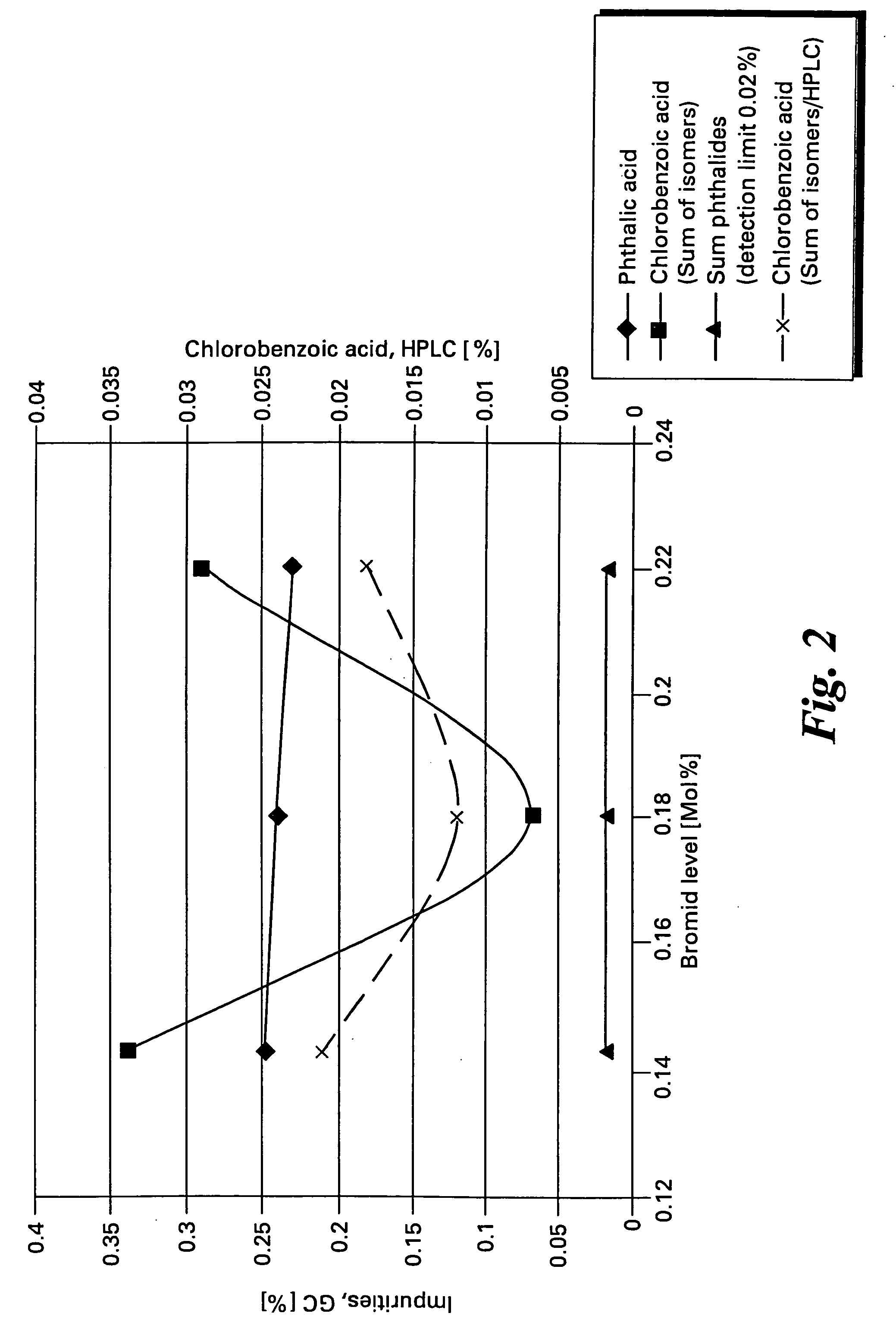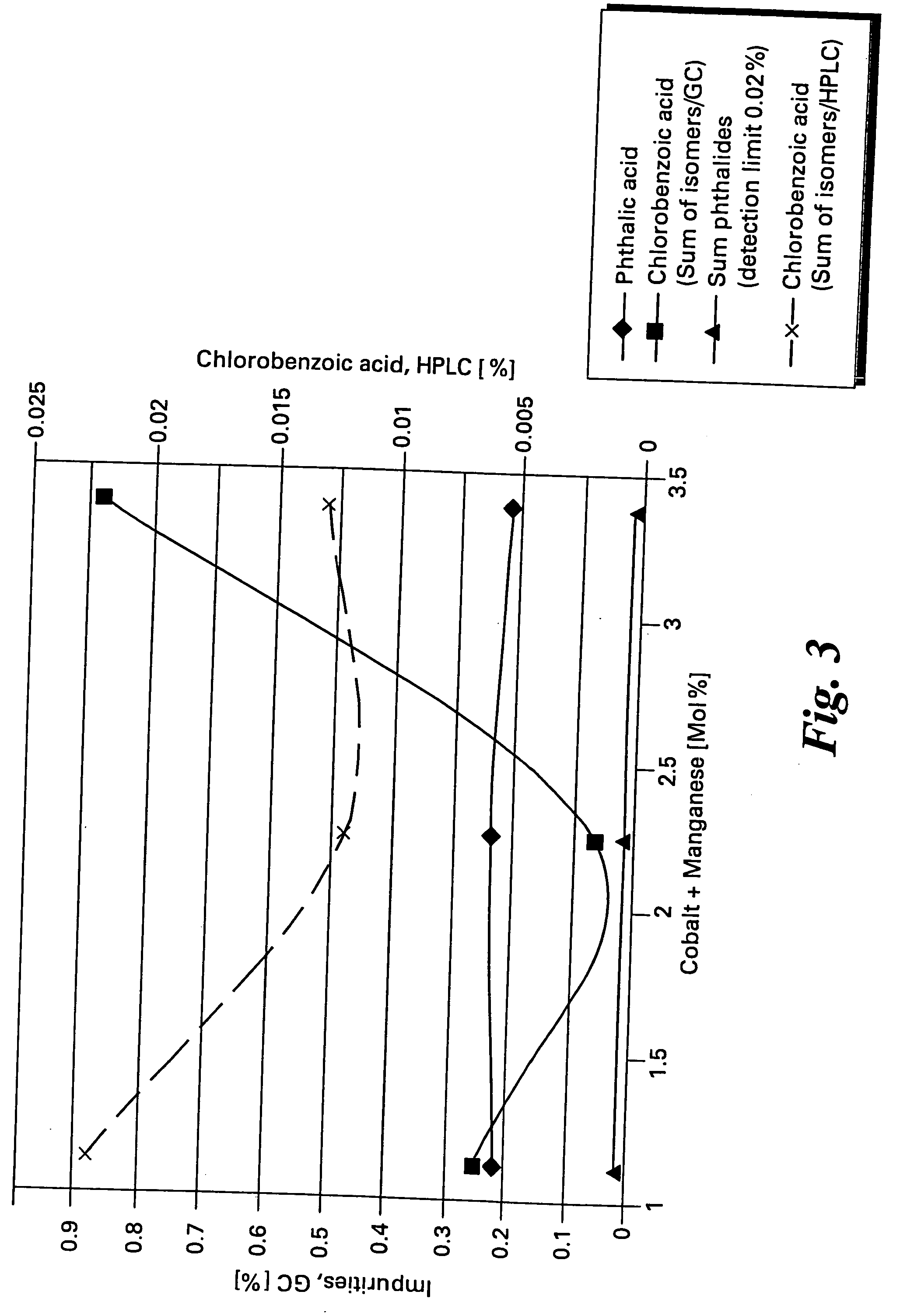Method of making halophthalic acids and halophthalic anhydrides
a technology of halogenated xylene and halogenated anhydride, which is applied in the preparation of carboxylic compounds, organic chemistry, chemistry apparatus and processes, etc., can solve the problems of reducing reaction selectivity, difficult oxidation of halogenated xylene, and high cost of halogenated xylen
- Summary
- Abstract
- Description
- Claims
- Application Information
AI Technical Summary
Problems solved by technology
Method used
Image
Examples
example 1
[0056] A 3.5 liter reaction vessel equipped as described above was charged with a 95:5 mixture of 4-chloro-o-xylene and 3-chloro-o-xylene (492.1g, 3.50 mol), acetic acid (1925 mL, 32.06 mol), cobaltous acetate tetrahydrate (13.1 g, 0.0526 mol, 1.50 mole % based on 3.5 moles of 3- and 4-chloro-o-xylene), manganous acetate tetrahydrate (6.4g, 0.0261 mol, 0.75 mole % based on 3.5 moles of 3- and 4-chloro-o-xylene), sodium bromide (0.6g, 0.0060 mol, 0.17 mole % based on 3.5 moles of 3-and 4-chloro-o-xylene), and sodium acetate (2.9 g, 0.0354 mol, 1.01 mole % based on 3.5 moles of 3- and 4-chloro-o-xylene). The reaction vessel was sealed and pressurized with nitrogen to 19 bar and then heated to about 160° C. Compressed air was then introduced into the reaction mixture at a rate such that the concentration of oxygen in the gas emerging from the reactor gas outlet valve was about 0.5%. The reaction temperature was maintained at about 160° C. for 1 hour and was then raised to about 175° C....
examples 2-14
[0057] Data for a series of oxidation reactions conducted as described in Example 1 together with modifications to reaction parameters indicated are gathered in Table 1. The data demonstrate the effectiveness of the method of the present invention to produce high yields of chlorophthalic acid while limiting the amount of chlorobenzoic acid by-products. In Table 1 the header “Variation” refers to the reaction parameter being varied in the Example, “standard “refers to the amounts of reagents and reaction conditions used in Example 2 which are given below.
Conditions of Example 2:
[0058] (A) Reagents
492.1g(3.5 Mol)3- / 4-Chloro-1,2-dimethylbenzene(95% 4-isomer + 5% 3-isomer)1925gacetic acid13.1g(52.5 mMol)Cobaltous acetate tetrahydrate6.4g(26.25 mMol)Manganous acetate, tetrahydrate0.65g(6.3 mMol)sodium bromide12.3g(150.0 mMol)sodium acetate (anhydrous)
(B) Oxidation Conditions
[0059] 19 barabs nitrogen pressure, stirrer speed 800 rpm. Temperature 152° C. at initial oxygen introductio...
example 2a
Cyclization Procedure Using Acetic Anhydride
[0061] The crude reaction product of Example 2 was divided into two identical fractions each weighing 1355 grams. One of the two fractions was subjected to distillation at atmospheric pressure (pot temperature 150° C.) until a total of about 952.9 grams of a mixture of water and acetic acid had been collected in the receiving vessel. The maximum head temperature was 122° C. When the head temperature reached 122° C. acetic anhydride (196.5 g, 1.93 mole) was added dropwise to the distillation flask and the resultant blue solution (no precipitate was observed) was heated at reflux (136° C.) for a two hour period. A mixture of acetic acid and acetic anhydride (198.6 grams) was then distilled off at atmospheric pressure (pot temperature 160° C.). Thereafter, vacuum was carefully applied to remove any remaining acetic anhydride, and the product chlorophthalic anhydride was distilled under vacuum. Two fractions were collected, the first distille...
PUM
| Property | Measurement | Unit |
|---|---|---|
| temperature | aaaaa | aaaaa |
| temperature | aaaaa | aaaaa |
| partial pressure | aaaaa | aaaaa |
Abstract
Description
Claims
Application Information
 Login to View More
Login to View More - R&D
- Intellectual Property
- Life Sciences
- Materials
- Tech Scout
- Unparalleled Data Quality
- Higher Quality Content
- 60% Fewer Hallucinations
Browse by: Latest US Patents, China's latest patents, Technical Efficacy Thesaurus, Application Domain, Technology Topic, Popular Technical Reports.
© 2025 PatSnap. All rights reserved.Legal|Privacy policy|Modern Slavery Act Transparency Statement|Sitemap|About US| Contact US: help@patsnap.com



